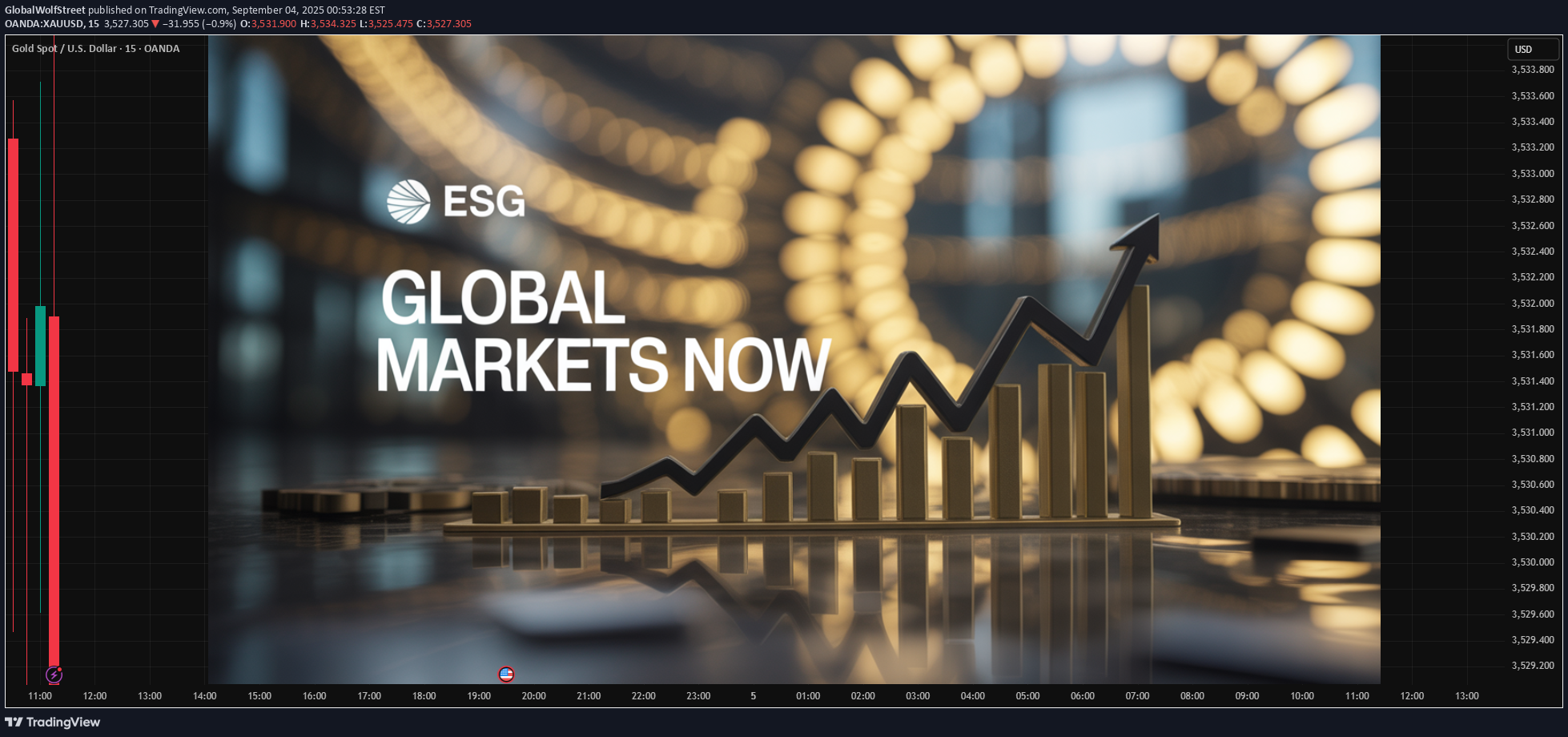Technical analysis by GlobalWolfStreet about Symbol PAXG on 9/4/2025

Chapter 1: Understanding ESG Investing 1.1 Definition of ESG Environmental (E): Concerns around climate change, carbon emissions, renewable energy adoption, water usage, biodiversity, pollution control, and sustainable resource management. Social (S): Focuses on human rights, labor practices, workplace diversity, employee well-being, community engagement, customer protection, and social equity. Governance (G): Relates to corporate governance structures, board independence, executive pay, transparency, ethics, shareholder rights, and anti-corruption measures. Together, these dimensions create a holistic lens for evaluating companies beyond financial metrics, helping investors identify long-term risks and opportunities. 1.2 Evolution of ESG 1960s-1970s: Emergence of ethical investing linked to religious and social movements, e.g., opposition to apartheid or tobacco. 1990s: Rise of Socially Responsible Investing (SRI), focusing on excluding “sin stocks” (alcohol, gambling, weapons). 2000s: The United Nations launched the Principles for Responsible Investment (PRI) in 2006, formally embedding ESG into mainstream finance. 2010s onwards: ESG investing surged amid global concerns over climate change, social inequality, and corporate scandals. 1.3 Why ESG Matters Risk Management: Companies ignoring ESG risks (e.g., climate lawsuits, governance failures) face financial penalties. Long-Term Returns: Studies show firms with strong ESG practices often outperform peers over the long run. Investor Demand: Millennials and Gen Z increasingly prefer ESG-aligned investments. Regulatory Push: Governments worldwide are mandating ESG disclosures and carbon neutrality goals. Chapter 2: ESG Investing Strategies Investors adopt multiple approaches to integrate ESG factors: Negative/Exclusionary Screening – Avoiding industries such as tobacco, coal, or controversial weapons. Positive/Best-in-Class Screening – Selecting companies with superior ESG scores relative to peers. Thematic Investing – Focusing on ESG themes like renewable energy, clean water, or gender diversity. Impact Investing – Investing to generate measurable social and environmental outcomes alongside returns. Active Ownership/Stewardship – Using shareholder influence to push for ESG improvements in companies. ESG Integration – Embedding ESG considerations directly into financial analysis and valuation. Chapter 3: ESG in Global Markets 3.1 North America The U.S. has seen rapid growth in ESG funds, though political debates around ESG (especially in energy-heavy states) have created polarization. Major asset managers like BlackRock, Vanguard, and State Street integrate ESG into products. Regulatory frameworks (SEC climate disclosure proposals) are shaping ESG reporting. 3.2 Europe Europe leads globally in ESG adoption, with strong regulatory support such as the EU Sustainable Finance Disclosure Regulation (SFDR) and the EU Taxonomy. Scandinavian countries (Norway, Sweden, Denmark) are pioneers in sustainable finance, often divesting from fossil fuels. ESG ETFs and green bonds dominate European sustainable investment flows. 3.3 Asia-Pacific Japan’s Government Pension Investment Fund (GPIF), one of the world’s largest, actively invests in ESG indices. China is promoting green finance under its carbon neutrality by 2060 pledge, but faces challenges in standardization and transparency. India is witnessing growth in ESG mutual funds, driven by SEBI (Securities and Exchange Board of India) regulations and corporate sustainability goals. 3.4 Emerging Markets ESG in emerging markets is growing but uneven. Investors face challenges such as limited disclosure, weaker governance, and political risks. Nonetheless, ESG adoption is rising in markets like Brazil (Amazon deforestation issues), South Africa, and Southeast Asia. Chapter 4: ESG Performance and Market Impact 4.1 Financial Returns Research indicates ESG funds often perform competitively with, or even outperform, traditional funds. Key findings include: ESG funds are more resilient during downturns (e.g., COVID-19 crisis). Companies with high ESG ratings often enjoy lower cost of capital. 4.2 Green Bonds and Sustainable Finance Green Bonds have grown into a $2 trillion+ market globally, financing renewable energy, clean transport, and sustainable infrastructure. Other innovations include sustainability-linked loans and social bonds. 4.3 Corporate Transformation ESG pressure has driven oil majors (e.g., Shell, BP) to diversify into renewables. Tech firms (e.g., Apple, Microsoft) are committing to carbon neutrality. Banks and insurers are phasing out financing for coal projects. Chapter 5: Challenges in ESG Investing Despite growth, ESG investing faces several obstacles: Lack of Standardization: Different ESG rating agencies use varied methodologies, creating inconsistency. Greenwashing: Some firms exaggerate ESG credentials to attract investors without real impact. Data Gaps: In emerging markets, ESG disclosures are limited or unreliable. Short-Termism: Many investors still prioritize quarterly returns over long-term ESG impact. Political Backlash: ESG has become politicized, particularly in the U.S., leading to regulatory tensions. Chapter 6: Case Studies 6.1 Tesla – A Controversial ESG Icon Tesla is often seen as a leader in clean technology due to its role in electric mobility. However, concerns about labor practices, governance issues, and supply chain risks (e.g., cobalt mining) complicate its ESG profile. 6.2 BP & Energy Transition After the 2010 Deepwater Horizon disaster, BP rebranded itself as a greener energy company, investing heavily in renewables. This illustrates how ESG pressure can push legacy firms toward transformation. 6.3 Unilever – Social & Environmental Responsibility Unilever integrates ESG principles deeply into its operations, focusing on sustainable sourcing, waste reduction, and social equity, earning strong support from ESG investors. Chapter 7: Regulatory and Institutional Landscape UN PRI: Global standard promoting ESG integration. TCFD (Task Force on Climate-Related Financial Disclosures): Encourages climate risk reporting. IFRS & ISSB (International Sustainability Standards Board): Working on global ESG reporting frameworks. National Regulations: U.S. SEC climate disclosures. EU SFDR & EU Taxonomy. India’s Business Responsibility and Sustainability Report (BRSR). Chapter 8: Future of ESG Investing The future of ESG investing is shaped by megatrends: Climate Transition: Net-zero commitments will drive massive capital flows into clean energy, green tech, and sustainable infrastructure. Technology & Data: AI, big data, and blockchain will improve ESG measurement, reducing greenwashing. Retail Investor Growth: ESG-focused ETFs and robo-advisors will make sustainable investing more accessible. Integration with Corporate Strategy: ESG will move from a reporting exercise to a core business strategy. Emerging Market Potential: Growth in Asia, Africa, and Latin America will define the next wave of ESG capital allocation. Conclusion ESG investing is no longer an optional strategy—it is becoming a main pillar of global finance. Investors, regulators, and corporations recognize that long-term economic prosperity is inseparable from sustainability, social responsibility, and sound governance. While challenges such as greenwashing, inconsistent standards, and political backlash persist, the momentum is undeniable. As global challenges like climate change, inequality, and governance scandals intensify, ESG investing provides a roadmap for channeling capital toward solutions that create sustainable financial returns and a better world. In the next decade, ESG will not just influence markets—it will define them.
